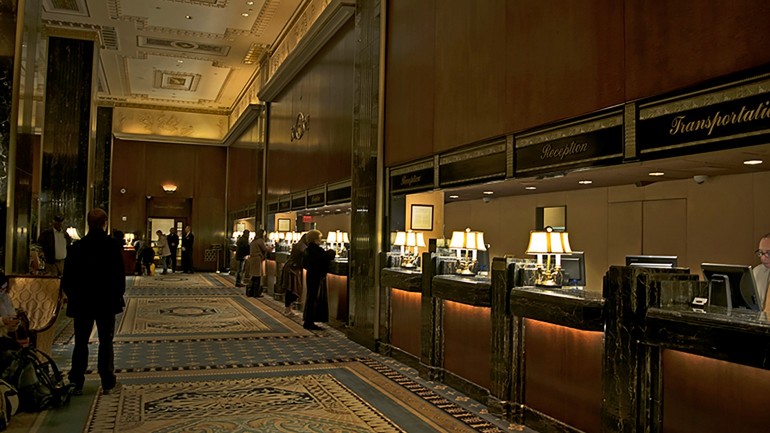Sponsored Listings:
Jay Hartman first stayed at the Waldorf Astoria in 1992, when he arrived in New York for a job interview. The hotel’s storied history was not lost on him. Nor was its age.
“The lobby was bursting with soul and character,” he recalled last week. “Then I get to my room, and it was tiny and looked like it had a kids’ bed. So I curled up in this bed, and the radiator was banging all night long.”
Hartman, now 47 and head of investments for Manhattan Beach, Calif.-based real-estate funding startup PeerStreet, recalled that although he “was so tired the next day” from lack of sleep, he “loved the hotel.”
After more than 120 years in business, 85 of them at its current Park Avenue location in Manhattan, the Waldorf Astoria — widely known as simply The Waldorf — shut its doors on March 1 for a redevelopment that will take up to three years and forever change the nature, if not the character, of what is arguably New York’s most famous hotel.
Yet, many in the industry said last week that the closure of the Hilton-managed property was overdue.
“There is always demand for this type of property,” said Kimberly Wilson Wetty, co-president of New York-based Valerie Wilson Travel. While noting that the hotel has long been popular with groups, Wetty added, “However, it is hard to remain timeless without aging, and as a result, the hotel has become tired, especially compared with [other] hotel product available in [New York] today.”
China-based Anbang Insurance Group, which bought the property from Hilton in 2015 for $1.95 billion, will likely convert the Waldorf Towers and its 181 units into luxury condominiums, reducing the number of rooms from 1,416 to slightly more than 1,200.
The Waldorf has been an official city landmark since 1993, and the owner is expected to meet with New York’s Landmarks Preservation Commission to outline what restrictions it faces in preserving and restoring certain elements of the property.
“Restoring this hotel to its place as the most luxurious hotel in New York is a key priority for the Waldorf Astoria brand,” Anbang said in a statement last week. “Through this restoration, [the] Waldorf Astoria will ensure that all global luxury travelers receive an unforgettable experience.”
Anbang did not disclose details about the cost of the project nor the final count of hotel rooms and condominiums.
The Landmarks Preservation Commission did not respond to a request for comment last week.
Anbang will be tasked with restoring the hotel, which occupies a full city block, to something approaching its one-time status as the world’s most luxurious hotel.
The hotel’s history began with the opening of the original Waldorf in 1893, and the Astoria was built next door four years later.
The hotel shuttered its original location in 1929 to clear space for the Empire State Building and opened at its current Park Avenue site in 1931.
In subsequent years, the hotel gained fame for hosting U.S. presidents, royalty and other heads of state and governments as well as providing a temporary residence for celebrities such as Marilyn Monroe, Frank Sinatra, Elizabeth Taylor and Muhammad Ali.
And, of course, the Waldorf gave its name to the eponymous salad.
Given its sheer size, physical layout and, as a landmark, an obligation to maintain many of its classic touches, the hotel in recent decades had been superseded in quality and reputation by newer, smaller luxury hotels such as the Four Seasons, St. Regis, Mandarin Oriental and Peninsula, according to Mark VanStekelenburg, New York-based managing director at CBRE Hotels Consulting.
“In any other market, this might be considered a luxury hotel,” VanStekelenburg said, noting that the Waldorf Astoria’s daily rates were often about half of the $800 to $1,100 commanded by what he called “ultra-luxury” properties. “But because of the large room count and its massive meetings facilities, it may not be ultimately positioned within that upper tier of luxury hotels. It’s more of a very large, upper-upscale hotel.”
The condominium component will be important in ensuring a return on investment in the improvements. While new luxury condominiums can sell for as much as $6,000 per square foot, VanStekelenburg estimated that units in restored or renovated buildings fetch anywhere between $2,500 and $4,000 per square foot, putting the potential sales price of a 2,000-square-foot condo at a redeveloped Waldorf Astoria in the $7 million range.
Such an extended shuttering for the redevelopment of a large, historical property isn’t unusual. The 1,504-room Fontainebleau Miami Beach went dark for more than two years before completing a $1 billion renovation in 2008, and Los Angeles’ Century Plaza, which closed last March, won’t reopen until next year, its room count reduced to 394 from 726.
What kind of effort will be required of Anbang to re-establish the property after remaining dark for so long remains to be seen. VanStekelenburg said that Anbang and Hilton (which has a 100-year management contract on the property) have the advantage of the Waldorf Astoria doing double duty as both a New York hotel icon and a Hilton luxury brand along with the likes of such notable properties as Southern California’s La Quinta Resort, the Arizona Biltmore and Hawaii’s Grand Wailea.
“The name won’t disappear from the consumer’s mind, but [the owners] have to keep up the excitement and buzz and maintain relevancy,” Wetty said. “Communication and sharing the progress of the renovation is critical.”
As for balancing the need to provide contemporary luxury accommodations amid such a historical setting, Hartman, who has stayed at the Waldorf a handful of times since that first visit, points to San Francisco’s 110-year-old Fairmont, which was renovated in 2014, as a model of elegant restoration.
“[Anbang] should aspire to what the Fairmont has done,” Hartman said. For example, he said, during his stays at the Fairmont, members of the service staff were fully steeped in the hotel’s history.
“That’s a world-class, historic hotel that had a world-class renovation,” he said.
Sourse: travelweekly.com










